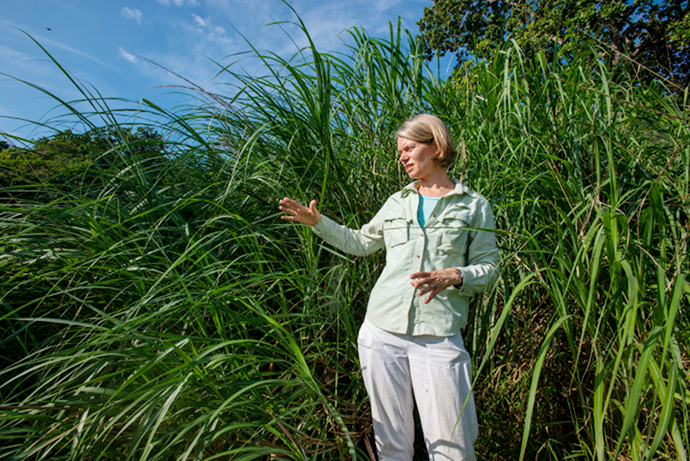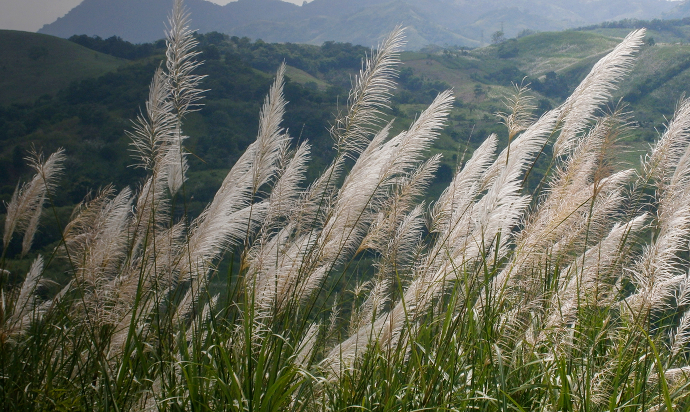Its white flowers and its historical association with the Panama Canal area inspired the common names paja blanca or paja canalera for this sugarcane relative, Saccharum spontaneum L. Photo by Kristin Saltonstall
Smithsonian scientist clears up Panamanian urban legend
by STRI
How did canal grass arrive in Panama? Smithsonian Tropical Research Institute (STRI) staff scientist Kristin Saltonstall compared the DNA of sugar cane relatives from around the world to find out.
Urban legends about the origins of canal grass in Panama abound, but the Smithsonian has new evidence that puts the question to rest. Canal grass is an invasive weed, native to Asia. Because its tiny seeds blow in the wind, it readily invades clearings and spreads to form impenetrable stands by budding from tillers and rhizomes. Once established, canal grass is challenging to eliminate. Fire burns the tops and stimulates the roots. Glassy hairs edging its leaf blades cut skin and dull machetes.
The most widespread story is that the Panama Canal Co. imported canal grass (paja canalera or paja blanca in Spanish, Latin name: Saccharum spontaneum L.) for erosion control. In other versions, the US Army brought it to landscape areas for military exercises or it arrived on ships transiting the canal during the 1950s or 1960s. Another study suggested that seeds or fragments of roots may have washed into the canal from a piece of earth-moving equipment from Thailand or Vietnam shipped through the canal in the 1970s.
“These explanations are all unlikely,” said Kristin Saltonstall, STRI staff scientist. “The first documentation of its presence in Panama is a report by the Missouri Botanical Gardens from 1948.”
A relative of sugarcane, S. spontaneum often arrives in out-of-the-way places as an escapee from breeding collections. Several previous reports from the Tropical Agriculture and Higher Education Research Center suggested that canal grass escaped from a US Department of Agriculture sugarcane breeding program at the Canal Zone Experimental Gardens (now Summit Nature Park) in the early 1940s. Saltonstall’s new genetic results support this idea.
In 1939, the US Department of Agriculture sent more than 500 different varieties of sugarcane and close relatives to the gardens. Breeders may have been concerned that they could be damaged by hurricanes at the sugarcane experimental station in Canal Point, Florida. The plants were allowed to flower in the gardens as part of ongoing sugarcane breeding trials between 1940 and 1945.
Saltonstall compared DNA extracted from leaves of plants she collected in Panama to DNA samples from a large, international collection of sugarcane and sugarcane relatives maintained by colleagues in Australia, including many of the accessions that were likely brought to Panama in 1939.
“The conditions were right, the plants were there and the timing is right,” Saltonstall said. “We can never say with 100% certainty that it came from the gardens, but it certainly looks like it, because DNA from canal grass in Panama is very similar to accessions from Indonesia in the germplasm collection. All of these plants also have high ploidy levels [many copies of the chromosomes in each cell] and come from the same maternal lineage.”
Sugarcane is the world’s largest crop. In 2018, Panama produced 2.9 million tons of sugarcane. It was first domesticated in Southeast Asia in the eighth millennium BC and gradually spread around the world. Today, a hectare of sugarcane (a cross between S. spontaneum and S. officinarum) yields between 30 and 180 tons of sugar. Sugarcane breeders are eager to improve yield by producing hybrids with other species of grasses, but as they continue to experiment, the possibility of escapes like this continues.
“This was not an intentional introduction,” Saltonstall said. “No one was thinking about invasive species at that time. More recently there have been escapes in the United States, in Florida and Louisiana. Germplasm collections need to be monitored and if there is an escape, it needs to be dealt with before it becomes a problem.”
Saltonstall will continue to study canal grass, fascinated by the way these large, invasive plants can take over an area and change its whole ecosystem. And as the world’s climate changes, Panama may become drier and more subject to fires, which often start in urban patches of canal grass near burning garbage or roads and then burn into the forest and clear new areas for the canal grass to invade. Canal grass can tolerate drier conditions and outcompete other plants that are not resistant to drought, which may give it an advantage if the climate becomes drier.

Kristin Saltonstall, STRI staff scientist, is fascinated by large, invasive grass species, which often radically change the ecosystems they invade. Photo by Sean Mattson.
Contact us by email at fund4thepanamanews@gmail.com
To fend off hackers, organized trolls and other online vandalism, our website comments feature is switched off. Instead, come to our Facebook page to join in the discussion.
These links are interactive — click on the boxes











